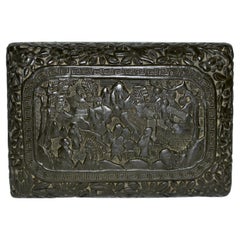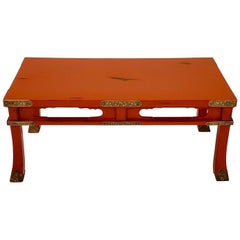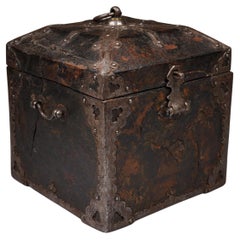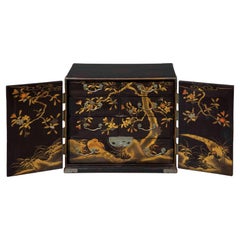Wool Lacquer
to
2
3
3
1
1
1
1
126,043
447
261
122
47
3
3
2
1
3
3
3
Material: Wool
Antique Black Lacquered Carved Box Village Life
Located in Somis, CA
This captivating early 20th-century lacquerware box transports you to a serene Chinese farming village. The fully carved lid unfolds a scene of daily life: two men, one seated on a ...
Category
Early 20th Century Chinese Qing Wool Lacquer
Materials
Kork, Wood, Lacquer
$95 Sale Price
38% Off
JAPAN 1880 Meiji Period Tebako Box In Red Lacquered Wood With Abalone Inlaid
Located in Miami, FL
Presentation Tebako box from the Japanese Meiji period (1868-1912).
Beautiful decorative presentation Tebako box from the Japanese Imperial Meiji period, circa 1880. This box has been meticulously crafted in a squared cushioned shape in wood with kara coating Kobayashi red lacquer, gilding, black lacquer and inlaid decorations of abalone shell, Raden. Tebako literally means "portable box", it is a toilet box containing the objects necessary for washing and make-up, especially blush mirror...
Category
1880s Japanese Meiji Antique Wool Lacquer
Materials
Abalone, Wool, Lacquer
$2,695 Sale Price / set
30% Off
18th Century Japanese Altar Table
Located in New York, NY
This lacquered 18th century Edo period altar table was probably made for the private shrine of an aristocratic home. There, it would have been placed before an image of a deity, and ...
Category
Early 18th Century Japanese Edo Antique Wool Lacquer
Materials
Brass
Related Items
17th/18th Century Wood, Leather and Metal Trunk, Tibet
Located in Point Richmond, CA
Trunk
Tibet
17th/18th century
Wood, leather, metal
H: 8 in x W: 8.5 in x D 8.5 in :: 20.3 x 21.6 x 21.6 cm
A slightly domed top hinged trunk with brass handles, closures and sculpte...
Category
17th Century Tibetan Tribal Antique Wool Lacquer
Materials
Metal
19th Century Japanese Lacquer Table Cabinet
Located in Richmond, London
A fine and rare Japanese black lacquer table or jewellery cabinet, exquisitely decorated in intricate detail, dating to the late Meiji per...
Category
Late 19th Century Japanese Meiji Antique Wool Lacquer
Materials
Metal
Japanese Samurai Abumi Stirrups Lacquer Edo, 18th Century
Located in Dallas, TX
Japanese Samurai Abumi Stirrups lacquer Edo late 18th century, early 19th century.
Measures: 12 inch length, 10 inch height, 5.5 inch width.
AVANTIQUES is dedicated to providing an...
Category
Late 18th Century Japanese Edo Antique Wool Lacquer
Materials
Iron
Japanese Negoro Style Lacquered Worship Stand, 17th-18th Century
Located in Fukuoka, JP
"Discover a piece of Japanese religious heritage with this exceptional Negoro lacquered stand. Crafted in the 17th to 18th century, this worship article stand is a prime example of e...
Category
Late 17th Century Japanese Edo Antique Wool Lacquer
Materials
Wood, Lacquer
$1,780
H 6.11 in W 10.63 in D 20.08 in
Small Japanese Lacquer Duck Incense Box, Kogo, Meiji Period, Late 19th Century
Located in Austin, TX
An exquisite Japanese Meiji Period small lacquer incense box, kogo, in the form of a duck or goose, late 19th century, Japan.
The delicate lacquer box, known as a kogo in Japanese, ...
Category
Late 19th Century Japanese Meiji Antique Wool Lacquer
Materials
Lacquer
$2,900
H 1.5 in W 2.88 in D 1 in
Japanese Maki-e Lacquer Stacking Box, Jubako, Meiji Period, Japan
Located in Austin, TX
A fine and impressive Japanese gold maki-e decorated black lacquer five-tier jubako with presentation tray, two lids, and the original tomobako storage box, Meiji period, late 19th c...
Category
Late 19th Century Japanese Meiji Antique Wool Lacquer
Materials
Lacquer
Japanese Momoyama Period Black Lacquer and Mother of Pearl Box, 16th Century
Located in Austin, TX
A fine and unusual Japanese black lacquer and mother of pearl inlaid box, Momoyama Period, 16th century, Japan.
The large box and cover featu...
Category
16th Century Japanese Edo Antique Wool Lacquer
Materials
Lacquer, Abalone
$9,800
H 4 in W 11 in D 15 in
Antique Japanese Red Black Lacquer Bamboo Food Carrier or Box
Located in Brea, CA
Antique japanese red and black lacquered Bamboo Food Carrier or Box, front side can be open
Dimensions: Height 18'' x width 15.5" x depth 11".
...
Category
20th Century Japanese Arts and Crafts Wool Lacquer
Materials
Bamboo
Japanese Rinpa Style Lacquer Box Meiji Period
Located in Atlanta, GA
A black lacquer tebako (hand box) with maki-e decoration and silver trim, circa late 19th century, Meiji period. The surface of the lid features a Rinpa style maki-e paint depicting ...
Category
1890s Japanese Japonisme Antique Wool Lacquer
Materials
Wood, Lacquer
Antique Chinese Hand Painted Lacquer Scene Gilt Fan with Lacquer Box
Located in Brea, CA
19th century antique Chinese hand painted lacquer scene gilt fan with original lacquer box.
Category
1830s Chinese Qing Antique Wool Lacquer
Materials
Lacquer
Japanese Marquetry and Lacquer Jewelry Chest, Meiji Period, circa 1900, Japan
Located in Austin, TX
A very attractive Japanese wood table top jewelry or collector's chest with marquetry and lacquer decoration, Meiji period, circa 1900, Japan. Previously in the collection of Asbjorn Lunde (1927 - 2017).
The chest is crafted in the form of a Chinese seal...
Category
Early 1900s Japanese Meiji Antique Wool Lacquer
Materials
Wood, Softwood, Lacquer
$3,400
H 15.75 in W 14.25 in D 7 in
17th Century Japanese Export Lacquer Cabinet with Depiction the Dutch Tradepost
Located in Amsterdam, NL
A highly important Japanese export lacquer cabinet with depiction of the Dutch East India Company tradepost Deshima and the annual Dutch delegation on its way to the Shogun in Edo
Edo period, circa 1660-1680
H. 88 x W. 100.5 x D. 54 cm
This cabinet includes a later European japanned stand, but also a modern powder-coated steel frame.
The latter can be designed and added to your specific needs.
The sides and front of the rectangular two-door cabinet are embellished in gold and silver hiramaki-e and takamaki-e on a black roiro lacquer ground with a continuous design. The two doors depict a long procession of numerous figures travelling on foot and horseback along buildings and a pagoda into a mountainous landscape. This is the annual court journey, Hofreis, of the Dutch from Nagasaki to the Shogun’s court in Edo. Three horseback riders are dressed as Dutch merchants and a fourth figure, probably het Opperhoofd, is seen inside a palanquin, norimon. Just about to cross the bridge, two men are carrying a cabinet like the present one.
Many Japanese figures on either side of the procession are engaged in various activities; some play musical instruments on board of small boats, others are fishing; figures inside buildings are depicted playing go, and farmers are tending to their rice paddocks. The upper part of the right door shows a large mansion, probably the local daimyo’s castle, with men kneeling before a man in the central courtyard.
The court journey fits in with the foreign policy of the shogunate which accorded a role to the VOC alongside China, Korea, and the Ryukyu Islands who also had to pay tribute. However, the VOC employees were traders, having low status in Japan’s social hierarchy, and they were received with less deference than were the state embassies from Korea and the Ryukyu Islands. Nevertheless, the contacts with the Dutch were a welcome source of information to the Shogun about Europe and European science and technology.
The left side of the cabinet depicts, in mirror image, a rare view of the artificial fan-shaped Deshima Island, the trading post for the Dutch in Japan. The island, where the Dutch flag flies, is surrounded by small Japanese boats and an anchored three-masted fluyt (cargo ship), flying Dutch flags, with on the stern the VOC monogram. On the bottom right a busy street of Nagasaki is shown, bordered by shops and leading up to the stone bridge. On the island the trees are beautifully painted, two cows can be seen, and the flagpole, all in very fine detail. Dutchmen and enslaved Malay are visible outside the buildings and two Japanese figures, probably guards, sit in a small hut in the centre.
A maximum of fifteen to twenty Dutchmen lived on the island at any time and soldiers or women were not allowed. Restrictions on Deshima were tight, and the merchants were only allowed to leave the island by special permission. The Opperhoofd had to be replaced every year, and each new Opperhoofd had to make a court journey to pay tribute, present gifts, and to obtain permission to Margaret Barclay eep on trading. In the distance, many birds fly above the hills and a four-story pagoda can be seen. The right side of the cabinet is painted with other horse riders and their retinue journeying through mountains.
The pair of doors to the front open to reveal ten rectangular drawers. The drawers are decorated with scenes of birds in flight and landscapes with trees and plants. The reverse of the left door with two thatched buildings, one with a ladder, underneath a camelia tree with large blooms; the right door with a three-story pagoda nestled among trees and both doors with a flying phoenix, ho-oo bird. The cabinet, with elaborately engraved gilt copper mounts, hinges, lock plates and brass handles, is raised on an 18th-century English japanned wood stand.
A pair of large cabinets...
Category
17th Century Japanese Edo Antique Wool Lacquer
Materials
Copper, Gold
$1,499,917
H 34.65 in W 39.57 in D 21.26 in
Recently Viewed
View AllMore Ways To Browse
Chinese Carved Cinnabar Red Lacquer
Korean Mother Of Pearl Furniture
Antique Chinese Fan
Japanese Containers
Chinese Lacquer Plate
Lacquered Japanese Bowl
Negoro Lacquer
Gold Lacquer Tray
Chinese Lacquerware
Korean Mother Of Pearl
Copper Hibachi
Lacquer Hibachi
Chinese Lacquer Fan
Chinese Lacquer Board
Namban Lacquer
Burmese Lacquer Trays
Japanese Laquered
Japanese Negoro Lacquer




